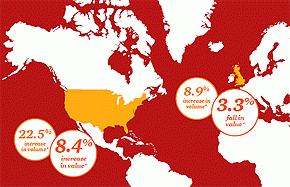
By Richard Longman*
 The wine industry is a very significant contributor to the New Zealand economy through the domestic economic activity it produces and the $1.2 billion of export receipts it generates.
The wine industry is a very significant contributor to the New Zealand economy through the domestic economic activity it produces and the $1.2 billion of export receipts it generates.
It also has a large role in presenting a positive image and profile of New Zealand to the world.
The chart below shows the growth in export receipts generated by the industry over the last four years, based on a ‘moving annual total’ or rolling 12 month basis.
The compound annual growth rate in export receipts over the last four years has been a staggering 10% per annum, from $815 million in August 2008 to $1,189 million in August 2012.
Export receipts for the year to August 2012 increased by $85 million or 7.7%.
This growth occurred in both packaged exports (up $56.6 million or 6%) and bulk wine exports (up $28.6 million or 19%).
While the absolute receipts are important, the realisation per litre is critical to the profitability of the industry.

The next chart shows that packaged export receipts per litre in NZD terms have been relatively flat to marginally negative over the last two years and have fallen 3.9% in the last 12 months.
Bulk wine was a topic of much debate and interest in the Strategic Review, with many participants calling for regulation of certain (but not all) bulk wine exports.
It was acknowledged that genuine reputation threats through adulteration of New Zealand wine or poor quality wine being exported potentially existed and the industry had limited means of protecting its reputation.

The Strategic Review recommended further actions be taken to protect New Zealand wine from reputational damage and instigate tighter rules on bulk wine exports.
New Zealand Winegrowers has been working with other agencies to develop controls on the export of bulk wine to protect the industry’s reputation. This does not however extend to restricting the export of quality wine to accredited bottling facilities in overseas markets.
It needs to be accepted bulk wine is an inextricable part of the industry and many bulk exports are made by or on behalf of brand owners seeking to reduce costs from the supply chain and retain control of the margin through the packaging and selling process. Most such parties have considerable amounts of invested capital or longer term contractual arrangements supporting the industry.
The ‘homeless’ bulk that is shipped to parties who will have it packaged and compete with New Zealand wine brand owners, presents the greater threat to the industry.
However, as noted in the Strategic Review, bulk wine provides an important safety value in periods where supply exceeds demand for New Zealand’s branded wines. As has been well documented, bulk wine exports increased markedly in July 2008 following the year’s huge vintage and that month was the first time that the MAT exceeded 5 million litres for all bulk exports.
The United Kingdom and Australia were the primary markets bulk wine was exported to, but both have been reducing since their peaks over the last twelve months.
There has been strong growth in bulk exports to the United States over the last two years; reflecting some New Zealand wine companies accessing bottling facilities in the US and some US wine companies building New Zealand wine labels and brands.
As a result of the low harvest this year, we anticipate that bulk wine exports will reduce further through to mid 2013, following the reduction over the last four months.
How much further bulk wine falls, in absolute terms and as a proportion of New Zealand wine exports post that period will very much depend on the size of the vintage 2013 harvest.
We expect the destination of New Zealand bulk wine will continue to change with further, potentially significant, falls in the volume going to the UK, further decreases in Australia and much greater volumes to the USA.
The extent of this change could see the USA being the largest market for New Zealand bulk wine within the next 12 to 18 months, subject to the size of vintage 2013.

------------------------------------------
Richard Longman is a partner at PwC who recently released the report, New Zealand Wine Insights from which this article is extracted. You can contact him here ». You can see the full report here ».
We welcome your comments below. If you are not already registered, please register to comment.
Remember we welcome robust, respectful and insightful debate. We don't welcome abusive or defamatory comments and will de-register those repeatedly making such comments. Our current comment policy is here.